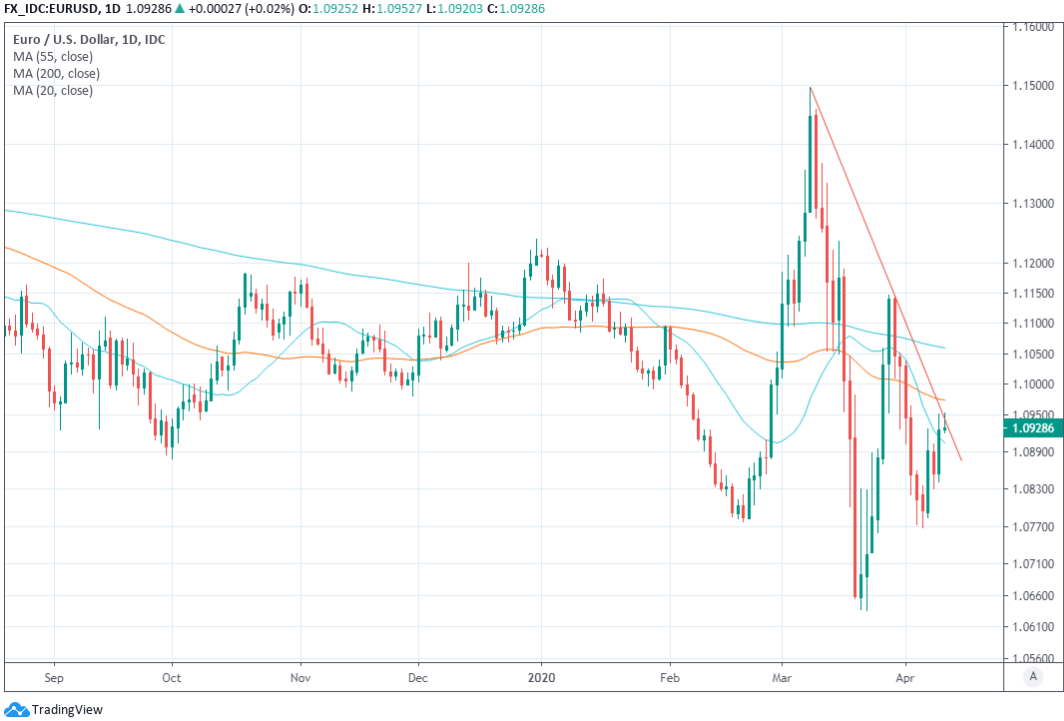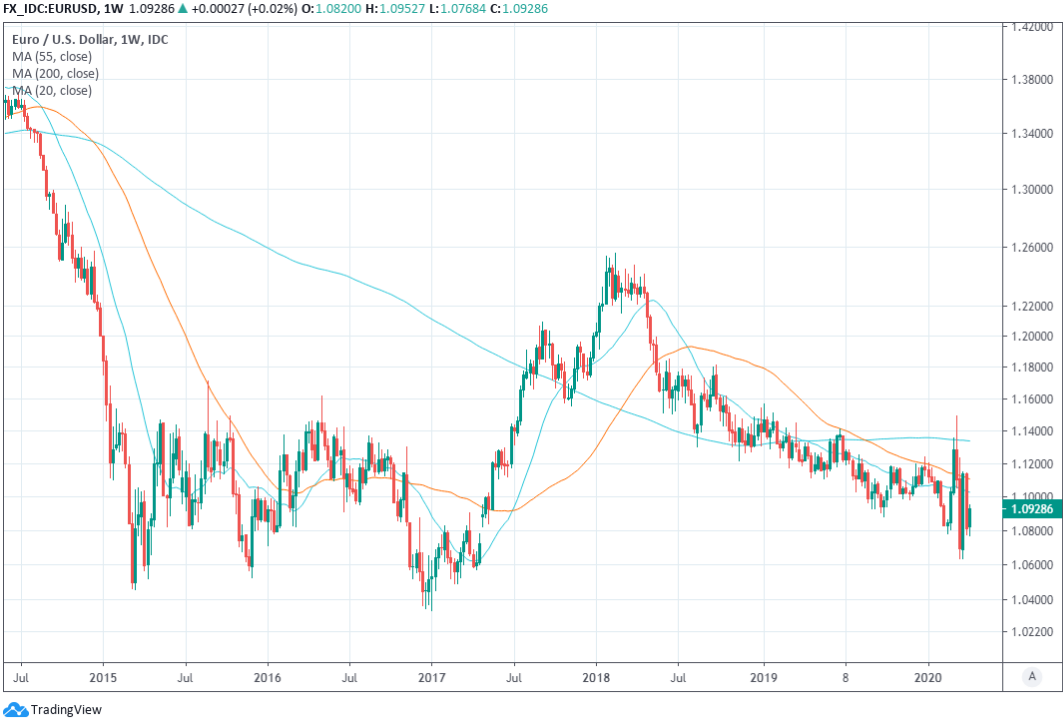Euro-to-Dollar Week Ahead: Stymied by Resistance on Charts as Markets Digest Eurogroup Package
- Written by: James Skinner
-
- EUR/USD faces immediate resistance on charts this week.
- "Accelerated downtrend" at 1.0957 seen blocking path higher.
- As EUR gears up for a new, narrow range-trade in short-term.
- But market sentiment, USD appetite key to EUR/USD trajectory.

Image © Adobe Image
- EUR/USD spot at time of writing: 1.0936
- Bank transfer rates (indicative): 1.0433-1.0508
- FX specialist rates (indicative): 1.0773-1.0839 >> More information
The Euro received a last minute leg-up ahead of the holiday weekend after Eurogroup finance ministers agreed on a fiscal support package for the bloc's economies, although it's facing immediate resistance on the charts and technical analysts say it could now range-trade for a while.
Europe's single currency closed the week 1.25% higher against the Dollar after shiting back into the black against the greenback as Eurozone finance ministers edged closer toward agreeing a European financial contribution to the coronavirus containment effort in the bloc's weaker economies.
The upward move was aided by weakness in the Dollar, which slumped while risk currencies rallied alongside stock markets that have now recovered from nearly half their historic March declines. Hopes that coronavirus' advance on the world economy is slowing were behind the moves, which leaves investors taking cues from the daily disclosures of new coronavirus infections and deaths in order to gauge whether the slowdown is being sustained.
Last week's gains lifted the Euro-to-Dollar rate further off the lows seen in the early days of April although they were not enough to lift it above the downward sloping trendline, or "accelerated downtrend" that began in March and which now litters the immediate path ahead. From the perspective of technicians, overcoming that level is necessary for the Euro to develop an upside bias.
"It looks likely to range near term. Failure at 1.0773 will target the 1.0636 March low and then 1.0340, the 2017 low. The market will find initial resistance at the accelerated downtrend at 1.0967 ahead of the 61.8% retracement at 1.1148/67 and while capped here will remain offered," says Karen Jones, head of technical analysis for currencies, commodities and bonds at Commerzbank.
Jones has a neutral outlook for the Euro-to-Dollar rate over the short and medium-term, which covers the next three weeks and three months respectively, although she's advocated 'short positions' to Commerzbank clients for the time being given that the single currency is at the top of what is anticipated to be a relatively narrow short-term trading range. She and the Commerzbank team entered their trade at 1.0830 and 1.0870 but have stop-losses at 1.0960.

Above: Euro-to-Dollar rate shown at daily intervals with accelerated downtrend (downward sloping red line) displayed.
The Euro-to-Dollar rate trajectory within its range will be heavily influenced by the general mood among investors, which is itself a function of the momentum behind the coronavirus' advance on the world economy, and increasingly the political backdrop in Europe.
"The EUR has traded in a sideways range since Tuesday morning and looks unlikely to make a clear break in either direction for the time being from a technical perspective with the 1.0800 level limiting its losses and 1.0900 dampening its gains offering solid resistance as a key marker since March, also as the 50% retracement of its late-March rally," says Juan Manuel Herrera, a strategist at Scotiabank.
European investors will have their first chance to give a verdict on the European fiscal response to the coronavirus when they return to their desks from the holiday weekend this Tuesday, which could have an impact on the Euro.
Squabbles between national leaders over how best to demonstrate the often vaunted European solidarity marred what was otherwise a supportive backdrop for the Euro last week and it cannot be ruled out that disagreements over the response the virus' economic impact will weigh on the currency again this week.
Eurozone finance ministers reached a last minute agreement Thursday to provide more than €500bn of aid to hard hit economies but the plan needs the unanimous endorsement of national leaders in the European Council and Italy's Prime Minister Guiseppe Conte has indicated he might not support it.
"Easier access to the ESM’s special credit line is meaningful and will lead to a sustained EUR/USD recovery because it ensures Eurozone financial stability. The ESM signals to investors that Eurozone countries have access to sufficient funds in case of need and can ward off any destabilising widening in sovereign bond yield spreads," says Elias Haddad, a strategist at Commonwealth Bank of Australia. "Buy EUR/USD at current level (1.0950)."

Above: Euro-to-Dollar rate shown at weekly intervals with various moving averages displayed.
The European response to the coronavirus pandemic has become politicised and could weigh periodically on the Euro if it incites Eurosceptic sentiment and rhetoric from the Southern European countries. However, CBA sees it as a gamechanger for the single currency because the financial backstop of the European Stability Mechanism should rule out a run on the bond markets of weaker economies like Italy while large fiscal expenditures improve the prospects of recovery after the crisis.
Haddad says last week's support package, when combined with relentless Federal Reserve (Fed) efforts to weaken the greenback, should put the Euro-to-Dollar rate on course for its 'fair value' equilibrium implied by forward interest rate differentials. That equilibrium is around 1.16, above the peak seen by the Euro in March when it was lifted by the liquidation of investor bets on higher yielding emerging market currencies, although markets will remain sensitive to coronavirus developments.
"An extension of economy‑wide lockdowns/strict social distancing measures well into May/June in Europe and the US would raise the risk of a more severe and protracted global economic contraction. This would trigger renewed broad‑based USD strength," Haddad warns.
Daily disclosures of new coronavirus infections and deaths are a key driver of market sentiment and demand for the likes of the Euro, which has rediscovered its correlation with other risk currencies of late. Before, back in March when global financial markets were in meltdown, the Euro had behaved like a safe-haven because it's low interest rates had previously been used to fund bets on greener pastures elsewhere although the subsequent adjustment of investor positioning is now thought to have run its course.
Negative shifts in sentiment could be caused either by a renewed increase in the spread of the infection within major economies or by any official statistics that suggest a wors-than-expected outcome for economies stemming from efforts to contain the virus. This means Chinese first quarter GDP data due out at 03:00 on Friday may also matter to the currency market because it will provide a loose indication of what might be ahead for the global economy.
“We expect the Dollar to remain firm as long as risky assets remain weak. If the S&P 500 makes new lows, consistent with our cross-asset views, the broad Dollar will probably make new highs,” says Zach Pandl, global co-head of foreign exchange strategy at Goldman Sachs in a recent research note.




